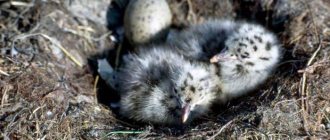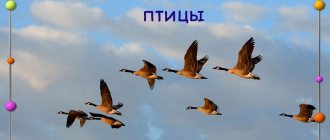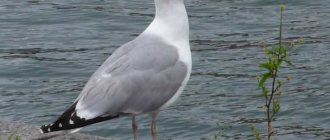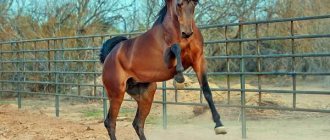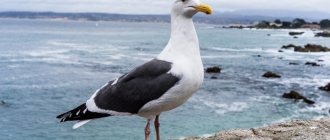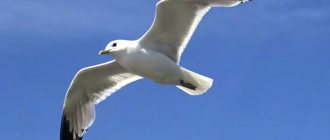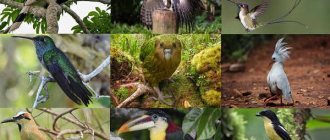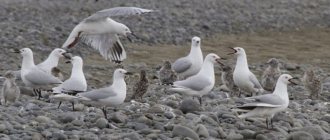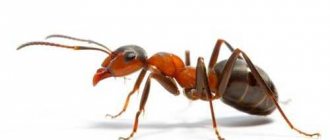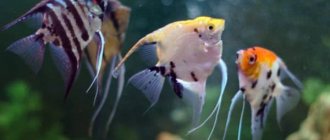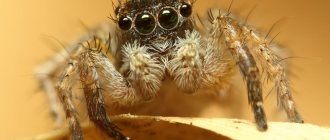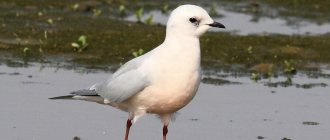Many people consider a bird like a seagull to be useless and even harmful, but this is far from the case. Of course, no one will argue that seagulls are very noisy, there is a lot of droppings in their nesting areas and they take garbage out of bins.
But on the other hand, due to the fact that these birds are scavengers, they clean the beaches, making their nests out of plastic, rags and other similar waste. And how can you imagine the coast without seagulls?
Origin of the species and description
Photo: Chaika
The gull genus belongs to the gull family and includes several dozen species that differ from each other in size (sometimes tens of times), color, habitat, preferred food, and much more. It was described back in 1758 by Carl Linnaeus under the name Larus. Two most characteristic species can be distinguished: the first is the common gull, also known as the lake gull, and the second is the sea gull. Lake fish are much smaller in size and live in fresh water bodies. Their scientific description was also made by Linnaeus in 1766, the name in Latin is Larus ridibundus.
Sea gulls are large and live close to the seas; they were described by the same Linnaeus in 1766 under the name Larus marinus. In total, the gull genus includes 23 species; previously some others were also included in it, but after genetic research they were transferred to related genera. The most ancient birds inhabited the Earth about 150-160 million years ago, but gulls are a much younger family. Its most ancient fossil representatives found lived on our planet after the great extinction at the end of the Cretaceous period - approximately 50-55 million years ago.
Video: Seagull
Apparently, they were among the families formed due to the fact that as a result of this extinction, many ecological niches were vacated, which were occupied by the descendants of the survivors, including birds. But even then it was far from the appearance of the seagulls themselves - the most ancient of them inhabited the Earth approximately 7-12 million years BC. Chaikovs are generally characterized by dynamic evolution: this group quickly adapted to life near water. At first these were inland reservoirs, and then they began to develop the seas. Gradually they received more and more evolutionary adaptations for life near and in water, and this process cannot yet be considered complete.
But what they definitely did was conquer most of the Earth, starting to settle from two centers: the remains of the oldest populations of gulls were discovered in Central Asia and South America. They succeeded in this thanks to their high fertility and ability to adapt.
Crow
Flocks of crows have chosen places close to humans; these birds are smart and intelligent. We offer a way to draw this bird easily and simply:
- On one diagonal we draw contour sketches of the head and torso, thickened towards the bottom and a triangular tail.
- We connect these parts with a stroke, completing the beak and two paws with claws.
- We detail the wing and give the tail a flat appearance.
- Having removed the basting, we move on to the plumage.
- Inside the eye we designate a highlight; an additional curve goes from it to the beak.
You can start shading with a black pencil, emphasizing the feather coating with contrast. If you choose the image of a magpie, then remember its peculiar black and white coloring and long tail.
Appearance and features
Photo: Seagull bird
Black-headed gulls weigh 200-400 grams and look slender. Sea gulls weigh many times more - 1.2-2 kg; they are large birds, reaching up to 80 cm in length. There are many other species, each with their own significant differences: two gulls of different species can look much more different in appearance than from birds with completely different names.
The systematization of gulls is quite complex; different ornithological schools can divide them according to their own systems. Additionally, the matter is complicated by the ability of gulls of different species to interbreed and produce offspring, the external characteristics of which most often combine the characteristics of both.
It is possible to identify common features that are characteristic of the vast majority of representatives of the genus: for example, gulls have a streamlined and long body with good aerodynamics, long wings and a square tail. The membranes used for swimming are clearly visible on the legs - after all, this bird can dive for prey, and sometimes simply frolic in the water.
They are characterized by white or gray plumage, with black markings often found on the head or wings. Young birds usually have feathers of a brownish tint, then with age they become lighter until they turn completely white in older gulls. The feathers are waterproof, making it easy for the seagull to swim.
The beak is strong and quite long, its end is curved - prey in water bodies is slippery, and a beak of this shape helps to hold it. The legs are short, black or red. It is not easy to distinguish between males and females; to do this, you need to know the small signs by which this can be done in each species.
Foreign populations
The seagull as a bird species is a common inhabitant of Russian latitudes. But some varieties are not found here.
Gray
The main breeding grounds of the population are South America (Peru, Chile). Frequent guests on the Pacific coasts. These representatives of the family can be called middle birds. The body length barely reaches 45 cm, and the seagull weighs about 360-450 g.
The bird fully lives up to its name - all its plumage is leaden in color. Unless the tummy is lighter in tone than the back. Yes, during the mating season the head becomes whitish-gray. The tail feathers are edged with black and white stripes. The paws and beak are charcoal-colored, and the irises of the eyes are brown.
Krasnomorskaya
The very name of the species indicates its “registration” - the Gulf of Aden and the Red Sea coast. You can admire her flight in the United Arab Emirates, Israel, Iran, Oman, and Turkey.
The small bird (43 cm long and 1-1.2 m wingspan) is distinguished by its slimness and beautiful posture. It has tall yellow legs and a thin, long, dark red beak with a black tip.
The back is dark gray in color. The chest and shoulders are a lighter shade. In some places you can see white feathers. On the wings, the color is soft gray at the base and gradually fades to black at the edges.
During the mating season, the head and neck are also covered with black plumage. A wide white border clearly stands out around the dark iris. From this the bird received its second name - white-eyed.
Delaware
This seagull is a representative of North America. Its nesting sites are found everywhere from the central states of the country right up to the borders of Canada. In winter, colonies migrate to the southern part of the continent. The bird has average sizes - 41-49 cm body and 1-1.2 m wingspan. The slender body is decorated with a large head set on a short neck. The species is distinguished by its thin, long, pointed wings and short tail.
The main plumage of the body is white below, gray above. Black color is present on the tops of the flight feathers. During the mating season, the head turns white, and a dark transverse stripe appears at the end of the yellow beak. The iris and paws of the bird are also colored yellow. There is no fuzz around the eyes - reddish skin is visible there.
Californian
This is another resident of the United States, spreading from Canada to Colorado and eastern California. For the winter, families go to the Pacific coast, where they raise their chicks.
Outwardly, the bird is slightly similar to the herring gull, but has a more rounded head and smaller size. The legs are yellow, as is the beak with a black ring at the end. The feathers on the neck are decorated with brown spots. The back and upper wings are gray as standard. All other parts of the body are snow-white.
Where does the seagull live?
Photo: White gull bird
They live on the coasts, both seas and rivers with lakes. Some seagulls even settle in swamps. In short, their range is very wide; these birds are found on different continents and in different climatic zones. Some species are migratory, others remain for the winter.
Each species has its own distribution area.
Thus, common gulls are common in:
- Russia;
- most of Europe;
- Turkey;
- Iceland;
- southwestern Greenland;
- Central Asia.
As can be seen from this, they are able to live in a wide variety of climates, from the subtropical Mediterranean and hot Uzbekistan, to cold Greenland, the Arkhangelsk region and Kolyma.
Some species of seagulls are synanthropic, that is, they settle near people and associate their way of life with them. Representatives of all types of people are not afraid, they often fly closer and begin to ask for food, they can even steal it while the owner’s back is turned. They often follow ships and see them off with characteristic cries.
Seagulls can be found not only near bodies of water, but also at a distance from them: in search of food, they can fly to agricultural land or to cities tens of kilometers away from their native lake or sea. You definitely won’t meet a seagull except high in the mountains, in the desert or in the dense jungle.
Interesting fact: Gull colonies are being studied very actively; their example is used to study the characteristics of animal behavior in such large communities. Many principles of the science of ethology arose precisely on the basis of studying how seagulls and their closest relatives, who also form similar communities, behave.
Capital "residents"
These seabirds are so accustomed to urbanization that they can even be seen in the Russian capital. Considering the types of gulls in Moscow , the most common ones are identified - blue and lake. Recently, silvery specimens have also been spotted.
Favorite habitats of the colonies are the Kopotnya region, Severny (near Dmitrovskoe highway), Lake Kiyovo. Such integration is associated with a shortage of natural food and a large number of landfills where food waste can be profited from. In this case, the seagulls took on the duties of scavengers.
Gray
Despite the fact that the bird weighs from 300 to 550 g, it cannot be called small - its body length is at least 46 cm. The wingspan reaches 1.2 m. It has an external resemblance to the herring gull, but the plumage is more saturated in color with a bluish tint. The tips of the wings are painted in black and white patterns. The yellow, slightly curved beak lacks the red dot characteristic of herring gulls.
It inhabits not only islands and sea coasts, but is also found in inland waters of Eurasia and North America. For the winter it migrates to upper Africa and settles in colonies in the Mediterranean Sea, where it breeds.
It differs slightly from other species in its way of feeding. Predation is not so active, content with what comes along. But it can take prey from the weaker gulls of another colony. Loves to eat berries.
Ozernaya
The most common bird found in the country. You can recognize it by its white body and nape, black head and gray wings. The tail feathers are also painted in the same shades. The legs and thin beak are deep red. The black-headed gull is considered a medium-sized bird - one wingspan reaches about a meter. An adult weighs 350 g, the body is 40 cm long.
The seagull settles both on sea coasts and near rivers and lakes. This species can also be found in cities with large bodies of water. It makes nests in the reeds, laying swamp-green eggs in them. The hatched chicks are ready to fly independently after 30 days.
What does a seagull eat?
Photo: Seagull in flight
The diet of these birds is varied; they can eat anything, including bread, sausage and ice cream. Tourists who leave food items in visible places are regularly convinced of this. But the basis of the seagulls’ menu is still the living creatures that they have to hunt.
This:
- shellfish;
- crabs;
- jellyfish;
- fish;
- squid;
- rodents;
- insects;
- carrion.
They can circle over the water, waiting for prey, for a very long time - if the hunt does not go well, they sometimes have to do this for several hours in a row without results. And they are capable of this - these birds are very hardy. As soon as they find prey, they quickly fly after it and dive into the water, and then grab it with their beak. They can use a smart approach and follow a large fish: it also hunts and guides the seagull to a smaller fish, after which it tries to intercept the catch. And even if not, when a large predator catches the prey and tears it into pieces, the seagull will try to intercept its piece - in the hope of this, they often circle the sharks.
If the prey managed to escape, then the seagull again has to go hunting, and its reserve of strength should be enough to make many unsuccessful dives in a row. Despite the dexterity of these birds, hunting is difficult, which is why seagulls prefer to beg for food from people. It’s easier for them to catch crabs or jellyfish washed ashore - the former run away slowly, and the latter cannot do this at all. That’s why seagulls love to feast on them and regularly visit the most productive places on the shore, onto which the waves wash up living creatures.
And if it has already managed to decompose a little, it doesn’t matter - seagulls do not disdain feeding on carrion. They can also examine garbage dumps located relatively close to the shore in search of something edible. Also, seagulls that have not found food for themselves at sea can catch amphibians, rodents, destroy other people's nests and eat eggs.
Now you know what a seagull eats. Let's see how she lives in the wild.
Illustration
Drawing a seagull with a pencil is not difficult, but it is also not interesting. It is much more enjoyable to create creative artistic work. For example, an illustration. How to draw a seagull step by step? You need to start working with the outline of the bird. We draw the silhouette and paws. Now you need to outline the outline of the wing and beak. Use a strip to mark the board on which the bird is standing. For further work we will need either ink or a black gel pen. She needs to work out the shadows on the bird, add volume to the legs and draw in the feathers. And now we turn an ordinary drawing into an illustration. We add to the seagull all sorts of attributes that are unusual for it. This could be a hat, a chest ornament, or a feather pendant. You can come up with something of your own. For example, instead of a cap, draw a cap or hat, instead of a pendant, draw a scarf. To make the illustration look more interesting, it is worth introducing additional colors. In our case, these are red and turquoise, but you can choose other shades.
Features of character and lifestyle
Photo: Sea gull
They are active during the day and spend most of their time trying to find food for themselves - and you need a lot of it, because seagulls are very voracious. In these searches they can fly many kilometers away from their habitat, but by the end of the day they return to their nesting sites to spend the night. They are reliably sheltered from the wind, and their large numbers protect them from the predators of seagulls.
They are characterized by ingenuity and they show it in different ways: for example, if a seagull cannot open the shell of a mollusk with its beak, then it throws it onto sharp stones from a height to break the shell. Seagulls can often be found on the streets of cities not far from bodies of water; they pester everyone they meet with food, in the hope that they will share it with them. They can fly to feed either singly or in flocks. The first option is fraught with conflicts between birds: they strive to rob their neighbor as soon as he gapes, and then he will certainly use his beak and claws to take revenge on the offender.
Their entire lifestyle is based on how good the weather conditions are in the coming year and how much food there is for them. If the year turns out to be bad, they may not lay eggs at all, but at the same time they often still sit on the nests as if they were hatching them. If conditions are bad year after year, they can move as a whole colony to another place.
The seagulls do not allow anyone to take a step into their small piece of territory around the nest - this applies to both relatives and everyone else. If another seagull finds itself in this territory, then a fight begins, and if it is invaded by a predator or a person, then the entire colony of seagulls starts screaming, they fly up into the sky and try to expel the newcomer, dousing him with droppings.
Interesting fact: Black-headed gulls often take prey from smaller birds. They simply swoop down on them, start hitting them with their beaks and force them to drop their prey in order to defend themselves. After that, they simply drive the poor fellow away and appropriate it for themselves.
Children's drawing
A child's creativity is always original. The fact is that children are not afraid to imagine. But boundless enthusiasm should be channeled in the right direction. For example, tell how to draw a seagull step by step, and invite the child to complete the work. How to depict a bird? First of all, you need to draw an outline with a clear line. Then detail it by drawing the paws, beak and cap. And now the child can add any attributes at his discretion. It could be a fish, a surfboard, an anchor pendant, etc. Then use a black gel pen to outline the drawing with strokes. Moreover, some lines should be made clearer, and others more blurred. Using colored pencils on top of a pen, you can add a little color to the drawing.
Social structure and reproduction
Photo: Seagull chick
Gulls live in entire colonies, each numbering from 500 to 5,000 individuals, whose nests are located close to each other - from half a meter to ten meters. Although life in such a colony has its advantages - first of all, it is protection from predators, it also has many disadvantages. The main thing is the quarrelsome nature of the seagulls themselves. They are each other's worst predators, and conflicts constantly arise between them due to the intrusion of one gull into the territory of another or over food.
Seagulls are monogamous and form a pair at once for many years - usually until the death of one of the partners. The breeding season begins in warm areas in April, and in colder areas in May or June. By that time, migrating gulls just have time to fly in and look around, to divide nesting sites - during this division, males often fight with each other for the best ones. When the fights subside, the males choose females for themselves, after which ritual feeding is carried out: if the female accepts food, she agrees to form a pair, after which the male brings her to his site.
A nest is built on it. For this, seagulls use branches, moss, algae, and shells. They often visit people for materials for them, and given their tendency to carry small objects, it may contain all kinds of beads, hairpins, and threads. Because of this behavior, coastal residents do not like them, but seagulls also perform a useful function: they remove a lot of garbage from the streets.
The nest itself is usually round and quite large, with a depression in the middle. They are located on rocks and cliffs, or right on the sea coast. If the shore is inaccessible to seagulls, they have to nest a little further away, then they try to settle on the plateau. The female lays 2-3 eggs of a dark color with green tones, after which she and the male hatch them in turn. The eggs take 20-30 days to develop, then voracious and noisy chicks are born - they begin to demand food immediately. They can walk independently a week later, but even after that their parents continue to feed them.
Both parents are involved in this, and even together it is difficult for them to feed several chicks: every day they require more and more food, feeding needs to be done 5-6 times a day, and a lot of small food always needs to be brought to it. At the same time, the birds still need to eat themselves - they are not always able to do this as well as before. Chicks begin to learn to fly at the age of a month, and fully master flight by two months, after which they begin to look for their own prey and settle separately from their parents. Puberty in gulls usually occurs in the second year of life, although in some species it comes earlier - at 8-10 months; There are also those who have to wait more than three years.
Fairytale variations
The firebird from the fairy tale has sweeping fan-like wings and a flowing plume-tail, a non-trivial fiery coloring, performed at its own discretion.
It is filled with figural patterns of different colors, from which streaks radiate, comparable to hair. Next, you need to blacken the edges of the plumage and fix the head crest.
Also interesting is a character who has an unusual, bright appearance. This is a circle with a polygonal beak, on the sides of which there are huge eyes with the obligatory “bags” under them. There is a crest on the head and a miniature tail on the left. You can start coloring.
Natural enemies of seagulls
Photo: Seagull bird
Most seagulls are fairly large birds; they fly quickly and have well-developed sense organs. As a result, they are not threatened by many predators—some species have almost no natural enemies at all. But for smaller gulls, these are large birds of prey, such as eagles or kites.
Attacks on gulls occur quite rarely, because flying into a flock is dangerous: usually the predator grabs one of the birds and retreats with it. Rarely, seagulls can be killed by sea creatures such as octopuses. Sometimes they are in danger on the ground - for example, they are hunted by foxes.
But predators do not cause as much damage to seagulls as their relatives themselves. They live in large colonies, where the aggressive and quarrelsome nature of these birds of prey is very evident: they constantly steal food from each other, fight over this or for other reasons, and even tend to attack the nests of their relatives.
Most often this happens on days when there is little prey and the birds begin to starve. It is quite difficult to keep the clutches intact, and then also to protect the chicks, when you also need to feed, and then feed the offspring. Therefore, many seagulls do not even have time to hatch from their eggs or die very young - they are simply killed by their relatives.
People also exterminate seagulls: in some areas they are considered a harmful bird that destroys valuable fish, although this is almost always not the case - they almost always hunt small fish that are not of commercial value. In some places there are simply too many of them, and they begin to interfere.
Pencil
How to draw a seagull? The easiest way is to draw the outline of the bird and detail it a little. You should start with an image of the body. It has the shape of an oval. Draw a circle to the front of this geometric figure - this will be the head, and to the back a triangle - this will be the tail. You can outline the legs with two lines at once. We use a large triangle to represent the wing closest to us, and a narrow triangle to represent the one farther away. Now we begin to give the bird its shape. First you need to draw the outline of the body. We outline it and round off the line of the tail. We draw an eye with a dot, and the beak will look like a rectangle rounded on one side. Detailing the wings. First we work with the one that is closer. We give the outer edge a slight bend, and draw a wave on the inner edge. We draw out the line of feathers and bring to it the stripes that come out from the sharp part of the wave. We give the far wing the shape of a jackdaw. If desired, some feathers can be shaded.
Dove of peace
When thinking about how to draw a bird for children, remember the dove - a fluttering creature with a flowering twig in its beak, which is a symbol of peaceful life.
Having outlined the oval body and the circle head, they are combined by adding a carved tail. The wings, open to the sides, can be compared in shape to an inverted trapezoid. The final stroke is to give the edges of the feathers fragmentation with zigzags.
Of course, it is impossible to cover all the inhabitants of heaven. Starting with one image and strengthening your skills, move on to the next example. Children will certainly enjoy this exciting pastime, which not only develops fine motor skills, but also expands their horizons and knowledge about the earth's fauna.
